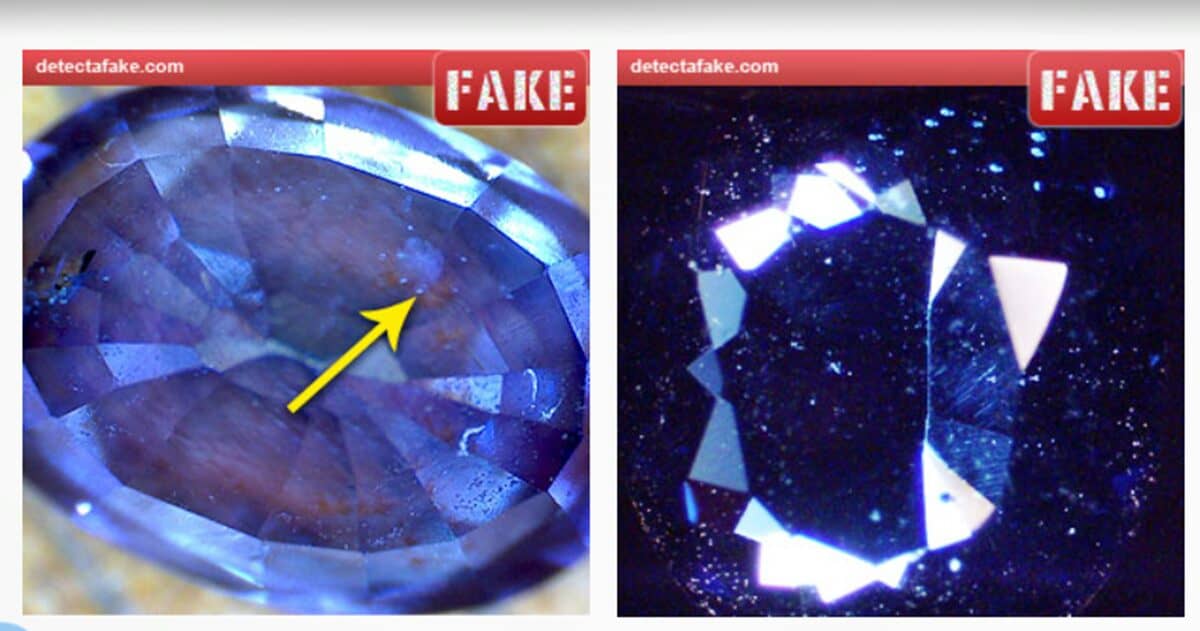How to detect fake Sapphire Gemestones
| Step | Gemstone Type | Identification Method | Characteristics |
|---|---|---|---|
| 1 | Real Sapphire | Inclusions through jeweler’s loupe | Natural flaws, visible inclusions |
| 2 | Synthetic “Flame Fusion Sapphire” | Lines visible under magnification | Man-made, lacks natural flaws |
| 3 | “Lead Glass Filled Sapphire” | Bubbles, intersecting lines | Low-quality filled with lead glass |
| 4 | Quick Test | Breath/Fog Test | Real sapphire evaporates fog quickly |
How to detect fake Sapphire Gemestones:
Welcome, gemstone enthusiasts! If you’ve ever wondered how to distinguish a genuine sapphire from its synthetic counterparts, you’re in the right place. No need for complex terminology; we’re here to guide you in a conversation-like manner.
Step 1: Spotting a Real Sapphire
Take a close look at Picture 1 in Step 1. The left example showcases a genuine sapphire, and here’s a tip: natural stones often have flaws, like the black speck seen here, known as an inclusion. To inspect it thoroughly, use a jeweler’s loupe. The real magic happens when these inclusions become visible under the light.
On the contrary, the right example in Picture 2 is a synthetic “Flame Fusion Sapphire.” Notice the lines? That’s a giveaway. Though appealing to the naked eye, these are entirely man-made.
Step 2: Cracking the Code of “Lead Glass Filled Sapphires”


Moving on to Picture 1 in Step 2. What you see here is the “Lead Glass Filled Sapphire” or “Composite Sapphire.” Using your loupe, you can spot bubbles in the glass. Additionally, watch out for intersecting lines resembling a spider web – a sign of low-quality sapphires filled with lead glass to mask flaws.
Step 3: The Vulnerability of “Lead Glass Filled Sapphires”

Now, take a glance at Picture 1 in Step 3. The vulnerability of “Lead Glass Filled Sapphires” lies in their reaction to chemicals, even common jewelry cleaners. Witness the irreversible damage caused in the presence of cleaning solutions or jeweler’s resizing heat.
Step 4: The Quick and Easy “Breath Test”
Lastly, let’s discuss the “Breath Test” in Picture 1 of Step 4. It may sound low-tech, but it’s effective. Breathe on the sapphire for a second – a genuine one clears up in about two seconds due to its efficient heat conductivity. If it takes longer, you might be dealing with a fake.
Frequently Asked Questions
1. Can I rely solely on the “Breath Test” to identify a real sapphire?
While the “Breath Test” is a quick indicator, it’s recommended to combine it with other methods for a more accurate identification.
2. Are all synthetic sapphires of lower quality?
Not necessarily. Some synthetic sapphires, like those produced using the Verneuil process, can be of high quality. It’s the specific type, like “Flame Fusion,” that tends to be lower in quality.
3. Can a real sapphire have no visible flaws?
Yes, it’s possible. Some natural sapphires can be relatively flawless, but the majority have some form of inclusion.
4. How do I avoid damaging my “Lead Glass Filled Sapphire”?
Avoid exposing it to harsh chemicals, including jewelry cleaners, and be cautious during any resizing processes carried out by a jeweler.
5. Is the jeweler’s loupe necessary for identification?
While not mandatory, using a jeweler’s loupe significantly enhances your ability to spot inclusions and other characteristics that distinguish natural from synthetic gemstones.
Conclusion
In the world of sapphires, distinguishing the real from the fake is an art. Armed with these insights and a keen eye, you can confidently navigate the realm of gemstones, ensuring that your prized possession is nothing but the real deal. Happy gem hunting!
